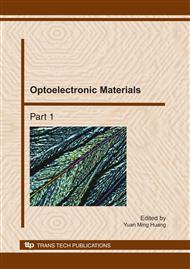p.1103
p.1107
p.1111
p.1115
p.1121
p.1125
p.1129
p.1133
p.1137
Electrodeposition of Ni and Ni-Cu Nanowires in Rectified Porous Anodic Alumina Membrane
Abstract:
Highly ordered Ni and Ni-Cu nanowires were electrodeposited into the micropores of the porous anodic alumina (PAA) template which was fabricated by the method of two-step anodizing and the thickness of barrier layer which was formed during the anodizing process was rectified by applying current limited anodization steps. The X-ray diffration (XRD) was used to characterize the Ni and Ni-Cu nanowires and the morphology of these nanowires was examined by the way of scanning electron microscopy (SEM). The SQUID magnetometry was used to investigate the magetic properties of the nanowires. It is found that the coercivity and remanence ratio of Ni-Cu nanowire is larger than that of Ni nanowire.
Info:
Periodical:
Pages:
1121-1124
Citation:
Online since:
November 2010
Authors:
Keywords:
Price:
Сopyright:
© 2011 Trans Tech Publications Ltd. All Rights Reserved
Share:
Citation:


